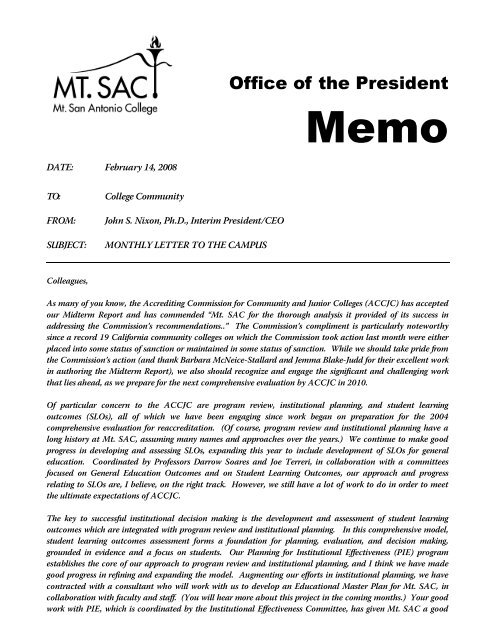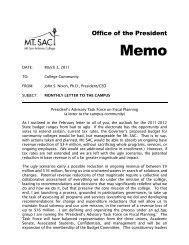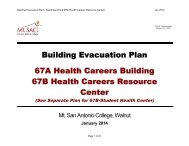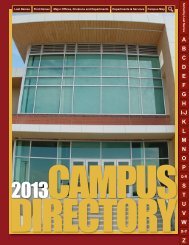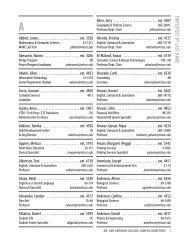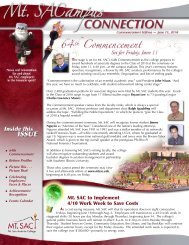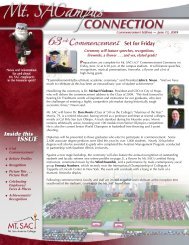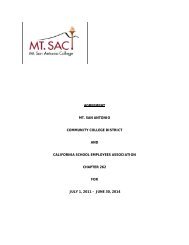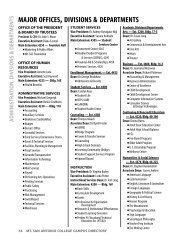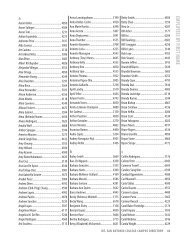February - Mt. SAC - Campus News
February - Mt. SAC - Campus News
February - Mt. SAC - Campus News
You also want an ePaper? Increase the reach of your titles
YUMPU automatically turns print PDFs into web optimized ePapers that Google loves.
Office of the President<br />
Memo<br />
DATE: <strong>February</strong> 14, 2008<br />
TO:<br />
FROM:<br />
SUBJECT:<br />
College Community<br />
John S. Nixon, Ph.D., Interim President/CEO<br />
MONTHLY LETTER TO THE CAMPUS<br />
Colleagues,<br />
As many of you know, the Accrediting Commission for Community and Junior Colleges (ACCJC) has accepted<br />
our Midterm Report and has commended “<strong>Mt</strong>. <strong>SAC</strong> for the thorough analysis it provided of its success in<br />
addressing the Commission’s recommendations..” The Commission’s compliment is particularly noteworthy<br />
since a record 19 California community colleges on which the Commission took action last month were either<br />
placed into some status of sanction or maintained in some status of sanction. While we should take pride from<br />
the Commission’s action (and thank Barbara McNeice-Stallard and Jemma Blake-Judd for their excellent work<br />
in authoring the Midterm Report), we also should recognize and engage the significant and challenging work<br />
that lies ahead, as we prepare for the next comprehensive evaluation by ACCJC in 2010.<br />
Of particular concern to the ACCJC are program review, institutional planning, and student learning<br />
outcomes (SLOs), all of which we have been engaging since work began on preparation for the 2004<br />
comprehensive evaluation for reaccreditation. (Of course, program review and institutional planning have a<br />
long history at <strong>Mt</strong>. <strong>SAC</strong>, assuming many names and approaches over the years.) We continue to make good<br />
progress in developing and assessing SLOs, expanding this year to include development of SLOs for general<br />
education. Coordinated by Professors Darrow Soares and Joe Terreri, in collaboration with a committees<br />
focused on General Education Outcomes and on Student Learning Outcomes, our approach and progress<br />
relating to SLOs are, I believe, on the right track. However, we still have a lot of work to do in order to meet<br />
the ultimate expectations of ACCJC.<br />
The key to successful institutional decision making is the development and assessment of student learning<br />
outcomes which are integrated with program review and institutional planning. In this comprehensive model,<br />
student learning outcomes assessment forms a foundation for planning, evaluation, and decision making,<br />
grounded in evidence and a focus on students. Our Planning for Institutional Effectiveness (PIE) program<br />
establishes the core of our approach to program review and institutional planning, and I think we have made<br />
good progress in refining and expanding the model. Augmenting our efforts in institutional planning, we have<br />
contracted with a consultant who will work with us to develop an Educational Master Plan for <strong>Mt</strong>. <strong>SAC</strong>, in<br />
collaboration with faculty and staff. (You will hear more about this project in the coming months.) Your good<br />
work with PIE, which is coordinated by the Institutional Effectiveness Committee, has given <strong>Mt</strong>. <strong>SAC</strong> a good
start in developing a comprehensive, ongoing, and effective program of institutional planning and evaluation,<br />
focused on student access and success.<br />
Using accreditation standards, ACCJC has set a high bar of expectations for program review, institutional<br />
planning, and SLOs. As we begin early work on the 2010 self-study for reaccreditation, under the leadership of<br />
Barbara McNeice-Stallard and Professor Kristina Allende, we all should become knowledgeable about those<br />
expectations and about the status of our work toward meeting them. <strong>Campus</strong>-wide dialogue and engagement<br />
on the three areas of concern are essential to our success with reaccreditation and with our students. ACCJC<br />
has published a rubric that colleges can use in assessing their status in relationship to the expectations defined<br />
by the Commission for the three areas related to institutional effectiveness. Listed below are the characteristics<br />
for each of the three areas that colleges must demonstrate in order to meet accreditation standards:<br />
Program Review – Rubric for Sustainable Continuous Quality Improvement:<br />
• Program review processes are ongoing, systematic and used to assess and improve student learning and<br />
achievement.<br />
• The institution reviews and refines its program review processes to improve institutional effectiveness.<br />
• The results of program review are used to continually refine and improve program practices resulting in<br />
appropriate improvements in student achievement and learning.<br />
Institutional Planning – Rubric for Sustainable Continuous Quality Improvement:<br />
• The institution uses ongoing and systematic evaluation and planning to refine its key processes and improve<br />
student learning.<br />
• There is dialogue about institutional effectiveness that is ongoing, robust and pervasive; data and analyses<br />
are widely distributed and used throughout the institution.<br />
• There is ongoing review and adaptation of evaluation and planning processes.<br />
• There is consistent and continuous commitment to improving student learning; and educational effectiveness<br />
is a demonstrable priority in all planning structures and processes.<br />
Student Learning Outcomes – Proficiency:<br />
• Student learning outcomes and authentic assessment are in place for courses, programs and degrees.<br />
• Results of assessment are being used for improvement and further alignment of institution-wide practices.<br />
• There is widespread institutional dialogue about the results.<br />
• Decision-making includes dialogue on the results of assessment and is purposefully directed toward<br />
improving student learning.<br />
• Appropriate resources continue to be allocated and fine-tuned.<br />
• Comprehensive assessment reports exist and are completed on a regular basis.<br />
• Course student learning outcomes are aligned with degree student learning outcomes.<br />
• Students demonstrate awareness of goals and purposes of courses and programs in which they are enrolled.<br />
We should all become familiar with the expectations and engage each other in dialogue on our status and on<br />
how we can expand and improve our work in the three areas. I look forward to meeting the challenge with<br />
you.<br />
JSN


